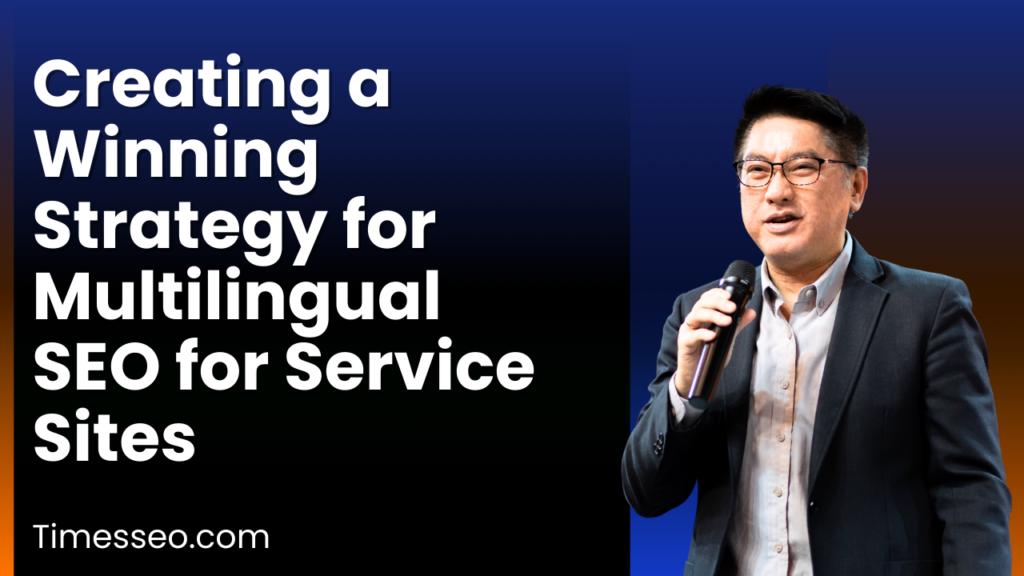
Creating a Winning Strategy for Multilingual SEO for Service Sites
Discover how to create a winning strategy for multilingual SEO for service sites, including language targeting, localized keyword research, and technical optimization to attract and convert audiences across multiple regions.
Table of Contents
Introduction
In today’s connected world, service providers aren’t limited by borders—your next customer could be halfway across the globe. But to reach them, your site needs to speak their language—literally and digitally. That’s where multilingual SEO comes in.
Why Service Sites Need Multilingual SEO
If you only optimize your site for one language, you’re essentially closing the door to millions of potential clients. Multilingual SEO ensures your services show up in searches no matter where your audience is.
The Role of SEO in Reaching Global Clients
A winning multilingual SEO strategy not only boosts visibility but also builds trust. Customers are much more inclined to use a service that they can comprehend in their mother tongue.
Understanding the Core Concepts
Difference Between Multilingual and Multiregional SEO
- Multilingual SEO targets multiple languages.
- Multiregional SEO targets multiple countries.
- Often, service sites need both—especially if they operate internationally.
Language Targeting vs. Country Targeting
For example, Spanish in Spain (es-es) vs. Mexican Spanish (es-mx) is the same language, but the demands of the market are different.
Defining Your Target Languages and Regions
Conducting Market Research
Identify where your services have the highest potential. Use tools like Google Trends and keyword research to find demand.
Prioritizing Based on Demand and ROI
Start with markets where you can see quick returns before expanding.
Choosing the Right Website Structure
ccTLDs for Country-Specific Sites
example.fr for France, example.de for Germany—great for geotargeting but requires more resources.
Subdomains and Subdirectories Pros and Cons
- Subdomains keep content separate but may dilute SEO authority.
- Subdirectories are easier to manage and share authority with the main site.
Implementing Hreflang for Language Targeting
Purpose and Benefits of Hreflang Tags
Hreflang tags tell Google which language version to show to which audience, preventing duplicate content issues.
Common Hreflang Mistakes and Fixes
Avoid wrong codes, missing return tags, and pointing to non-existent pages.
Keyword Research for Multilingual SEO
Using Native Language Keywords
Direct translations often miss search intent—native speakers know the exact phrases people use.
Avoiding Direct Translations
Instead of “lawyer services” translated word-for-word, use the local equivalent that people actually search.
Content Creation and Localization
Importance of Culturally Relevant Content
A slogan that works in one country might be confusing or offensive in another.
Working with Native Speakers
They ensure your content sounds authentic and resonates with the audience.
Technical Performance and User Experience
Page Speed for International Visitors
Use a CDN to serve content faster to users worldwide.
Responsive Design Across Languages
Make sure your layout adapts to different text lengths and reading directions.
Metadata and URL Optimization
Localized Title Tags and Meta Descriptions
Write compelling, keyword-optimized metadata for each language version.
SEO-Friendly URL Slugs for Each Language
Keep URLs short, clear, and in the target language.
Sitemap and Indexing Strategy
Separate Sitemaps for Each Language
Helps search engines discover and index your content correctly.
Submitting to Google Search Console
Submit each sitemap under the correct domain or subdirectory.
Structured Data for Multilingual Sites
Adding Schema Markup in Multiple Languages
Make that the content language on each page corresponds with the structured data.
Link Building for International Markets
Local Backlink Strategies
Partner with regional directories, blogs, and news outlets.
Collaborating with Regional Partners
Joint campaigns can help you earn quality local backlinks.
Tracking and Measuring Performance
Setting Up Analytics for Multiple Languages
Create separate views or filters to track performance per language.
Tracking Conversions per Market
Measure leads or sales for each targeted region.
Common Pitfalls to Avoid
Mixing Languages on the Same Page
Confuses both users and search engines.
Ignoring Cultural Sensitivities
What’s acceptable in one culture might be offensive in another—research before publishing.
Conclusion
Creating a winning multilingual SEO strategy is about more than just translating text—it’s about understanding your audience, optimizing for their search habits, and providing a seamless experience. Done right, it can open the doors to entirely new markets and revenue streams.
Frequently Asked Questions
Start with one or two high-potential languages before expanding.
No, it’s just one part—you also need keyword research, localization, and technical optimization.
Yes, but always have native speakers review for accuracy and tone.
Not always, but localized content helps engagement.
Typically 3–6 months, depending on competition and quality of optimization.
Table of Contents
Popular Posts
-
 Affordable Technical SEO Audit for Small Business: A Complete Guide26 Jun 2025 Blog
Affordable Technical SEO Audit for Small Business: A Complete Guide26 Jun 2025 Blog -
 How to Get an Affordable Technical SEO Audit for Small Business27 Jun 2025 Blog
How to Get an Affordable Technical SEO Audit for Small Business27 Jun 2025 Blog -
 The Ultimate Local SEO Audit Checklist for Startups28 Jun 2025 Blog
The Ultimate Local SEO Audit Checklist for Startups28 Jun 2025 Blog -
 Local SEO Audit Checklist for Startups: A Beginner’s Guide28 Jun 2025 Blog
Local SEO Audit Checklist for Startups: A Beginner’s Guide28 Jun 2025 Blog -
 Top On-Page SEO Audit Steps for Service Websites Every Business Should Know29 Jun 2025 Blog
Top On-Page SEO Audit Steps for Service Websites Every Business Should Know29 Jun 2025 Blog -
 Technical SEO for WordPress: The Ultimate Beginner’s Guide01 Jul 2025 Blog
Technical SEO for WordPress: The Ultimate Beginner’s Guide01 Jul 2025 Blog -
 The Impact of On-Page SEO Audit Steps for Service Websites on UX01 Jul 2025 Blog
The Impact of On-Page SEO Audit Steps for Service Websites on UX01 Jul 2025 Blog -
 Technical Mobile SEO Audit Tips for Developers02 Jul 2025 Blog
Technical Mobile SEO Audit Tips for Developers02 Jul 2025 Blog -
 Complete SEO Backlink Audit Guide for Better Google Rankings03 Jul 2025 Blog
Complete SEO Backlink Audit Guide for Better Google Rankings03 Jul 2025 Blog -
 Boost Your Rankings with Technical SEO for WordPress01 Jul 2025 Blog
Boost Your Rankings with Technical SEO for WordPress01 Jul 2025 Blog






